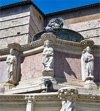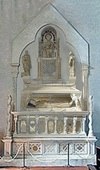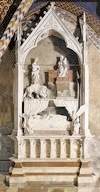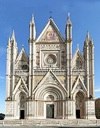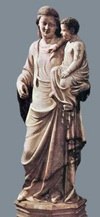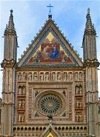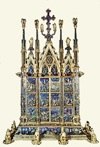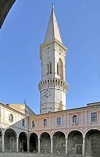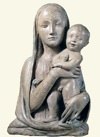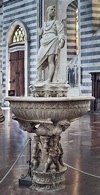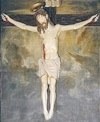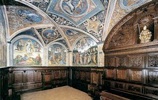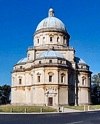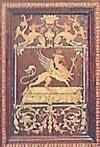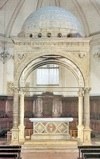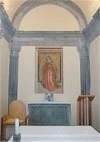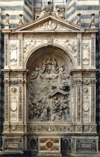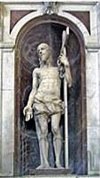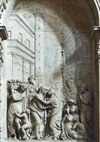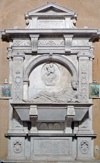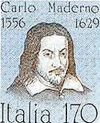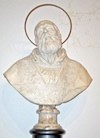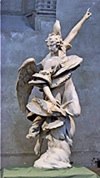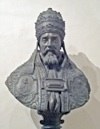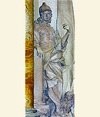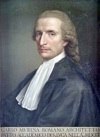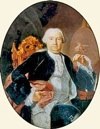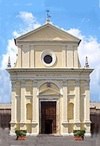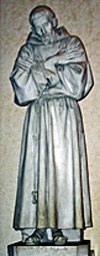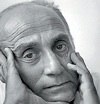

Nicola Pisano (died ca. 1284) & Giovanni Pisano (died ca. 1315)
The masterpieces of this father and son were, respectively:
-
✴the pulpit (1255-60) in the baptistery of Pisa; and
-
✴the pulpit (1302-10) of the Duomo, Pisa.
They worked together on the Fontana Maggiore, Perugia in 1277-8, just before Nicola’s death.
Arnolfo di Cambio (died 1302)
Arnolfo di Cambio, who trained under Nicola Pisano (above), became the leading artist of his day. He is first documented in Rome in 1277, in the employment of King Charles d’ Anjou. His first documented work was on the Fontana Minore in Perugia in 1277-81, and his first signed work was the monument (ca. 1282) to Cardinal Guillaume de Braye in San Domenico, Orvieto (illustrated here). He left Rome for Florence in 1296 and it was there that he died.
Ramo di Paganello (died after 1314)
Ramo di Paganello was documented in his native city in 1281, when he returned from exile in France. No signed or securely documented examples of his work are known. He seems to have been capomaestro at the Duomo, Orvieto in ca. 1302-10, and subsequently to have worked at the Angevin court of Naples. The so-called Monument of the Emperor of Constantinople (ca. 1300) in the Lower Church of San Francesco Assisi (illustrated here) is attributed to him and/or to his associate, Rubeus.
Lorenzo Maitani (died 1330)
Lorenzo Maitani spent the last two decades of his life working on the Duomo of Orvieto, and its facade is his most important surviving work. He is also documented at Montefalco and Perugia.
Ambrogio Maitani (died after 1346)
Ambrogio Maitani, the brother of the more famous Lorenzo Maitani (above), was the city architect of Perugia in 1317-46. His most important work there was the extension of the Palazzo dei Priori (illustrated here) to provide accommodation for the Priors and the Capitano del Popolo. Although he is not documented as a sculptor, a number of works of sculpture in Perugia are attributed to him, including:
-
✴the figures of the patron saints of Perugia above the entrance to the Palazzo dei Priori (now in the Galleria Nazionale); and
-
✴the monument to Pope Benedict XI in San Domenico Vecchio (later recomposed in San Domenico).
Andrea Pisano (died ca. 1348) and Nino Pisano (died ca. 1368)
Andrea Pisano sculpted the reliefs (1330) on the bronze south doors of the Baptistery, Florence. He was capomaestro at the Duomo Orvieto in 1347-8, and was succeeded by his son, Nino Pisano, in 1349-50. He executed this figure (1347) for the Duomo, Orvieto in Pisa. One of the two angels that were associated with it is attributed to Nino Pisano, as is a figure of Christ. All of these figures are now in the Museo dell’ Opera del Duomo, Orvieto.
Andrea Orcagna (died 1368)
From Florence
Ugolino di Vieri (died ca. 1380)
The goldsmith Ugolino di Vieri is best known for the Reliquary of the Sacro Corporale (1337-8) in the Cappella del Corporale of the Duomo, Orvieto (illustrated here). He also signed two other surviving works in Umbria:
-
✴the Reliquary of St Sabinus (ca. 1340) for San Giovenale, Orvieto, which is now in the Museo dell’ Opera del Duomo; and
-
✴a gilded silver paten (mid 14th century) for San Domenico, Perugia, which is now in the Galleria Nazionale.
Bernardo Rossellino (1409-64)
Bernardo Rossellino, trained as an architect and sculptor in Florence in the 1420s. He was papal architect to Pope Nicholas V (1447-55): according to Giorgio Vasari. he worked on the fortresses of Narni, Orvieto and Spoleto in this capacity in 1449. He was also papal architect to Pope Pius II (1458-64), for whom (inter alia) he designed the new city of Pienza in 1459-62. Among his last works was the design of the campanile (1463-8) of San Pietro, Perugia (illustrated here), which was based on that of the campanile of the Duomo, Pienza.
Agostino di Duccio (died ca. 1481)
The sculptor Agostino di Duccio fled from his native Florence in 1446, after being accused of stealing silver from a church. He worked on the Tempio Malatestiana in Rimini in 1450-7, after which he moved to Perugia. His many works there include this bust (1460s) of the Madonna and Child, which probably came from the facade of San Francesco and is now in the Galleria Nazionale. He also executed some funerary monuments for the Geraldini family of Amelia.
Antonio Federighi (died 1483)
Antonio Federighi served as capomaestro of the cathedral workshop in his native Siena for three decades (1450-81). He held the same post at Orvieto in 1451-6. He was probably responsible for:
-
✴introducing the row of niches for twelve statues of the apostles above the rose window in the facade of the Duomo in order to correct its proportions;
-
✴sculpting the water stoup inside the Duomo (illustrated here); and
-
✴executing the figure (1456) of the Eritrean Sibyl on the facade.
Giuliano da Maiano (1432-90)
From Maiano, near Fiesole, based in Florence
Giuliano da Maiano, who was among the leading architects and sculptors of Florence in the 15th century, is particularly known for his woodcarving and intarsia work.
-
✴The intarsia panels (ca. 1475-82) of the studiolo of Duke Federico da Montefeltro in Palazzo Ducale, Gubbio are (like those of the equivalent room in Palazzo Ducale, Urbino) attributed to him.
-
✴He designed the choir stalls (1489-91) of the Duomo, Perugia (albeit that Domenico di Tasso completed the work after Giuliano’s death).
[Temporary link to Giuliano da Maiano]
Giovanni Tedesco (late 15th century)
Giovanni Tedesco carved three documented wooden crucifixes in Umbria, for:
-
✴the Abbazia di San Pietro, Perugia (illustrated here) in 1478;
-
✴the chapel of the the Palazzo dei Priori, Terni, in 1491; and
-
✴Santa Maria Argentea, Norcia, in 1494.
A number of other broadly contemporary crucifixes in Umbria are attributed to him.
Domenico del Tasso (1440-1508)
From Florence, based in Perugia in ca. 1490-1500
Almost all of the works securely attributed to the wood carver Domenico del Tasso are or were in Perugia:
-
✴ He completed the choir stalls (1489-91) of the Duomo, Perugia after the death of their designer, Giuliano da Maiano.
-
✴Together with his sons, Francesco and Marco, he executed the wooden panelling (1490-93) of the Sala dell’ Udienza (Audience Chamber) of the Collegio del Cambio (illustrated here).
Cola di Matteuccio da Caprarola (died after 1519)
Cola da Caprarola is documented in relation to Santa Maria della Consolazione, Todi (illustrated here) from 1508, at the start of the project, until 1512. He is sometimes named in the associated documents as the architect, but nothing in his known career suggests that he could have designed the church. He also worked on the remodelling of the Duomo of Foligno in 1512-5.
Andrea della Robbia (1435-1525)
Work in Umbria by or attributed to Andrea della Robbia or his workshop include:
-
✴two works in or from Santa Maria degli Angeli, Assisi:
-
•the altar dossal (ca. 1490) that is now in the Museo della Portiuncula (illustrated here); and
-
•a statue (ca. 1490) of St Francis that is now in the Cappella del Transito;
-
✴a number of reliefs (early 16th century) in Città di Casello;
-
✴a relief (early 16th century) of the Coronation of the Virgin from a wayside tabernacle outside Montefalco, which is now in the Pinacoteca there; and
-
✴figures (early 16th century) of the Annunciation from SS Annunziata, Norcia, which are now in the Museo della Castellina.
Antonio Bencivenni (died 1528)
Antonio Bencivenni was a woodcarver who was based in Perugia in ca. 1498-1518 and subsequently in Todi. His surviving work in Umbria includes:
-
✴a cabinet and a set of choir stalls (1501) from the sacristy of Santa Maria delle Grazie, Città di Castello, which are now in the Pinacoteca there;
-
✴the completion of the choir stalls of San Domenico, Perugia in 1498;
-
✴the main portal (1501) in the Collegio del Cambio, Perugia and the wooden decoration of its chapel (a detail of which is illustrated here) in 1509-16; and
-
✴the portal (1513-21) of the Duomo of Todi.
As an old man, he worked alongside his son, Sebastiano, on the choir (1521-30) of the Duomo of Todi, but died before the work was complete.
Rocco di Tommas0 (died 1529)
Works in Umbria by or attributed to Rocco di Tommaso include:
-
✴the monument (1514) to SS Eutychius and Spes in the Abbazia di Sant’ Eutizio, Norcia;
-
✴the pulpits (1519) of the Duomo, Perugia:
-
✴a tabernacle (illustrated here) and two altars (1515) in Santa Maria Maggiore, Spello; and
-
✴two works in Trevi:
-
•the Altare del SS. Sacramento (1521-2) in Sant’ Emiliano; and
-
•a tabernacle (16th century) in Santa Maria di Pietrarossa.
Francesco di Guido di Virio (died 1535)
Text
Antonio da Sangallo il Giovane (1484-1546)
Antonio da Sangallo the Younger began his career in Rome, under Bramante and then Raphael, becoming capomaestro at St Peter’s after Raphael’s death in 1520. He was the pre-eminent papal architect, particularly in the years after the sack of Rome in 1527. He worked throughout the papal states, primarily for the papacy. The bore of the Pozzo di San Patrizio (1527-37), which he designed for Pope Clement VII at Orvieto, is illustrated here.
Simone Mosca (1492–1553)
Simone Mosca began his association with Orvieto in 1535 and became capomaestro of the Duomo there three years later. He remained in the city until his death. Among his many works there, he supervised the construction and decoration of the Cappella dei Magi (1535-46, illustrated here) in the right transept of the Duomo, and of its pendant Cappella della Visitazione (1547-54).
Michele Sanmicheli (1484-1559)
Michele Sanmicheli, who came from Verona, was capomaestro of the Duomo of Orvieto in 1509-25. He also worked in the city for the Petrucci family: the relief illustrated here is from Tomba Petrucci (1516-24), which is in the family’s subterranean chapel in San Domenico.
Raffaello da Montelupo (1504-66)
Raffaello da Montelupo survived the sack of Rome in 1527 and went on to work there under Michelangelo. He moved to Orvieto in 1552, and sent the last 15 years of his life as capomaestro at the Duomo. This statue (ca. 1550) of the Risen Christ, which survives in the Duomo, is attributed to him: was probably inspired by the similar statue (1518-20) by Michelangelo in Santa Maria sopra Minerva, Rome.
Giacomo Barozzi da Vignola (1507-73)
From Vignola, near Modena, based in Rome
Vignola had a very successful career in Rome, where he often worked for the papacy. He also worked in Umbria, often as an advisor, at the behest of prominent nobles with interests there.
[Temporary link to Vignola]
Francesco Mosca, il Moschino (died 1578)
Francesco started work at an early age, working under his father, Simone Mosca (above) on the Duomo of Orvieto. His finest work there was the central relief (1547-54) on the Cappella dell Visitazione, illustrated here. He left Orvieto for Florence after his father’s death in 1553.
Giovanni Antonio Dosio (1533-1611)
The sculptor Giovanni Antonio Dosio was documented in Amelia in 1564. His sketches of a number of Roman artefacts in the city survive. The funerary monument of Bartolomeo II Farrattini (1561-4) in the Cappella Farrattini of the Duomo there is attributed to him.
Carlo Maderno (1556-1629)
Carlo Maderno, who moved to Rome to work with his uncle, Domenico Fontana, became one of the leading architects of the Baroque period. His work in Umbria included:
-
✴work on the drainage of the Rieti Plain outside Terni in 1598;
-
✴the Barberini Monument (ca. 1623) on the Fonte di Piazza, Spoleto; and
-
✴the rebuilding of San Domenico, Perugia in 1625-32.
Alessandro Algardi (1598-1654)
Alessandro Algardi succeeded Gianlorenzo Bernini (below) as papal court sculptor in 1644, with the accession of Pope Innocent X. Works in Umbria that are attributed to him include:
-
✴an ivory crucifix (1635) in the Museo Diocesano of Foligno; and
-
✴this bust (ca. 1640) of St Philip Neri in the Museo Diocesano of Spoleto, which from San Filippo Neri there.
Francesco Mochi (1580-1654)
Duke Mario Farnese secured Francesco Mochi’s first major commission, which was for the two figures of the Annunciation (1605-8) in the Duomo of Orvieto. Mochi subsequently executed two bronze equestrian statues in Piacenza, of Rannuccio Farnese (1612–20) and Alessandro Farnese (1620–29), followed by an important figure (1629-40) of St Veronica, in St Peter’s, Rome. His other works for the Duomo of Orvieto were figures of St Philip (1609-10) and St Thaddeus (1638-44). All four figures are now exhibited in the ex-church of Sant’ Agostino.
Gianlorenzo Bernini (1598-1680)
Gianlorenzo Bernini was the most important sculptor in Rome for much of the 17th century. Works that were sent from Rome to Umbria include:
-
✴portrait busts of Bartolomeo and Diana Roscioli (17th century) in the Museo Diocesano of Foligno (attributed); and
-
✴this bust (1640-4) of Pope Urban VIII in the Museo Diocesano of Spoleto, which Urban VIII commissioned from Bernini for the Duomo there, in memory of his period as Archbishop of the city.
Agostino Silva (1620-1706)
Agostino Silva worked extensively in San Rufino: this figure of Fortitude (1672) on the Altare di San Filippo Benizi there is signed and dated by inscription. This seems to have followed a period in Spello, where work in Santa Maria Maggiore and San Lorenzo is attributed to him.
Sebastiano Cipriani (died ca. 1740)
Cipriani’s most prestigious commission in Umbria was the design (1717) of Palazzo Collicola in Spoleto (illustrated here). He also began the remodelling of the Duomo of Foligno after the earthquake of 1703, and he provided a design for the Oratorio del Gonfalone there in 1724.
Carlo Mureno (1713-64)
Carlo Murena trained as an architect in Rome under Luigi Vanvitelli (below), and later looked after Vanvitelli’s practice in Rome. His first major commission, in 1740, was as director of the construction of the church and monastery of Montemorcino Nuova, Perugia, to Vanvitelli’s design. He executed a number of other commissions in Umbria in 1760-2 (in Foligno, Perugia and Terni).
Luigi Vanvitelli (1700-73)
Luigi Vanvitelli was one of the most important Italian architects of the 18th century. His most important commission was the design and construction of the Royal Palace of Caserta for King Charles VII of Naples, which occupied the last twenty years of his life. He executed two projects in Perugia in 1740-2. He also produced a design for the remodelling of the Duomo of Foligno in 1754, and advised on the project in 1771-3.
Virginio Vespignani (1808-82)
Virginio Vespignani was a prominent architect at the court of Pope Pius IX. He worked extensively in Orvieto, where his brother held the bishopric in 1842-65. His most important work there was the design of the new church of Santa Maria dei Servi, in 1857.
Giovanni Dupré (1817-82)
Giovanni Dupré was a leading sculptor of the Risorgimento. Two of his works survive in Umbria:
-
✴a portrait (1853) of Ludovico Gualterio in the Museo dell’ Opera del Duomo, Orvieto; and
-
✴this figure (1881) of St Francis, which was his last work. His daughter, Amalia Dupré completed it and gave it to the church of San Rufino, Assisi on the 700th anniversary of the birth of St Francis.
Alessandro Arienti (1833-96)
From Milan
Alesandro Arienti was the city architect of Perugia from 1865 until his death. He redesigned much of the city following the demolition of the Rocca paolina. His most important work here was the Palazzo del Governo (1869-72), later known as the the Palazzo della Provincia e Prefettura.
Emilio Greco (1913-95)
Emilio Greco moved to Rome in 1943 and was Professor of Sculpture at the Liceo Artistico there in 1948-52. In 1956, he won the sculpture prize at the Venice Biennale. Among his last works was the monument (1965–6) to Pope John XXIII in St Peter's, Rome. He had associations with two cities in Umbria:
-
✴He executed the bronze doors (1962-4) of the Duomo of Orvieto. The collection of works that he donated to the city in 1991 formed the basis for the Museo Emilio Greco in Palazzo Soliano.
-
✴He exhibited in the “Incontri per le Strade” in Spello in 1983. A number of works that he donated to the city in 1989 are now exhibited on the second floor of Palazzo Comunale Vecchio.
Return to the home page on Umbria
